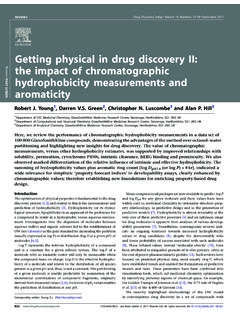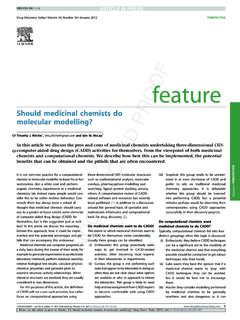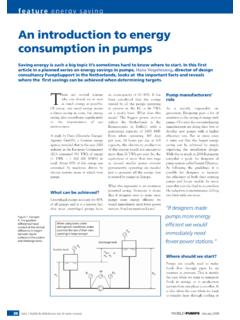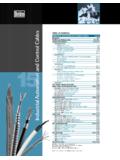Transcription of Energy consumption in pumps – friction losses
1 0262 1762/08 2008 Elsevier Ltd. All rights reserved WORLDPUMPSA pril 200820feature Energy saving In the first article in this series1, the concepts of geodetic differential head and possible pressure differences in the suction and discharge tanks were discussed. Together these determine the differential pressure to be delivered by a pump to ensure the required flow. However, the introductory article did not deal with the effects of friction losses , which will now be gone into more of friction losses friction losses refer to the difference in pressure needed to overcome the pressure drop during flow through pipes (Figure 1).
2 Such losses only occur as a result of dynamic movement caused by flow; consequently, the pressure difference associated with this process is referred to as the dynamic differential pressure. friction losses can only occur when flow actually takes was shown in the previous article, the pump must produce a sufficient difference in pressure to bridge the geodetic differential head and possible pressure differences in the tanks. This is known as the stationary differential pressure, referring as it does to the difference in pressure required for motionless fluids. Once a fluid begins to flow through a pipe it will therefore be necessary to overcome the extra difference in pressure caused by friction losses .
3 This will have to be provided by the pump, in addition to it overcoming the stationary differential pressure. The pump s differential pressure will always be made up of the sum total of the stationary and dynamic differences in friction losses always represent an absolute Energy loss, they need to be reduced as much as possible, if Energy is to be saved. As explained previously, a 1 bar pressure difference at a 100 m3/h pump capacity costs 4 kWh. A reduction in friction loss from 1 barto bar will result in the Energy loss being reduced by 50%, thereby saving 2 kWh every hour. This is why it is possible to achieve significant savings, especially in (near) continuous operations (365 days per year, 24 hours per day = 8760 hours per year!)
4 What influences friction losses ? It is common knowledge that friction losses have a significant effect on our daily lives. For instance, we are all aware that cars need more Energy and therefore more fuel at higher speeds than at low speeds. Luckily for us, car designers have already done a great deal to limit this: they have their designs tested in wind tunnels and try to reduce drag as much as possible by adapting the design. However, despite optimal designs, friction still occurs and increasingly so at higher velocity of the fluid is also of great influence in pipe flow. So, just as a car designer adapts the design to reduce drag, the pump system designer will have to do the same.
5 How can this be achieved when testing in a wind tunnel is not an option?Fortunately, much research into friction losses has already been done. This knowledge and experience has been laid down and published in handbook form. One example is the much-used Crane Technical Paper TP-410 entitled Flow of Fluids through Valves, Fittings and Pipe2. This well-known English text In this second article in a series on Energy savings in pumps , Hans Vogelesang, director of Netherlands-based design consultancy PumpSupport, deals with some practical aspects of fluid mechanics. In particular, he looks at the influence of pipe diameter, bends and other features of piping systems on friction loss and Energy consumption .
6 PppinpinfoutpoutFlow directionLpf=-Figure 1. During pipe flow, friction loss causes the downstream pressure to consumption in pumps friction 204/10/08 7:29:46 PM4/10/08 7:29:46 PMWORLDPUMPSA pril 2008 Energy savinggives the standardized method and details needed to calculate pressure loss resulting from flow in pipe systems. D e s i g n e r s w o r l d w i d e u s e C r a n e Technical Paper TP-410 as the standard work in the field of flow in pipes, valves and other in-line components such as bends and reducing pieces. It provides not only the theory, together with graphs and formulas, but also practical workplace examples and readily useable resistance factors.
7 The latter are based on extensive testing and enable precise calculations to be made regarding which equipment to employ in a particular system. TP-410 was originally published in 1942. Nowadays, the more-recent editions are deemed to be essential reading for engineers, designers, researchers and students in all areas of technology that deal with pipe flow. Reducing friction loss In all cases of pipe flow a pressure difference is required to overcome friction factors play a part in the pressure difference. Firstly, there is the friction that results from the particles flowing along the rough inner pipe surface and from the difference in velocity of the individual particles.
8 In the case of turbulent flow, the particles will additionally all be moving in different directions, causing extra turbulence losses . This is known as viscous friction and can be calculated using the Darcy-Weisbach equation (see Box 1).Secondly, there is the extra pressure difference required to produce a change in the flow (flow direction through bends and T-pieces, and acceleration through reducing pieces, non-return valves, etc.).How these friction losses can be calculated is shown in detail in Box 1. Any such calculations will be affected by a large number of factors. If you wish to save Energy then the friction losses must be kept as low as possible by selecting the most favourable conditions for any particular significant number of these conditions are, however, determined by the mechanics of the process and cannot be altered.
9 For example, the volume and viscosity of the fluid to be transported are two factors that are largely pre-determined. Extremely viscous fluids could be heated beforehand, but the downside is the extra Energy this would consume. However, in the case of fluids that need to be heated during the process anyway, it does make good sense to do this before pumping actually 5 in Box 1 shows how friction losses can be reduced when the r e c o m m e n d a t i o n s b e l o w a r e a d h e r e d t o . Reduce pipeline length The length of a pipeline is crucial, as Equation 5 shows. friction loss can be reduced by designing a system that significantly limits the transportation distance.
10 Positioning a storage tank 214/10/08 7:29:47 PM4/10/08 7:29:47 200822feature Energy savingclose to the system could result in the pipe length being halved, thereby cutting Energy losses by 50%.Pipe diameter selection According to Equation 5, the fluid velocity will have a quadratic effect on friction losses , reducing friction loss by a quarter when the velocity is halved. The reverse will of course also apply: double the velocity and the differential pressure will increase fourfold. The designer should therefore concentrate on limiting the velocity in the pipe. Note that the rate should not be too low, as this would require the pipe diameter to be disproportionately large for a particular volume and the cost of the pipes unnecessarily high.






